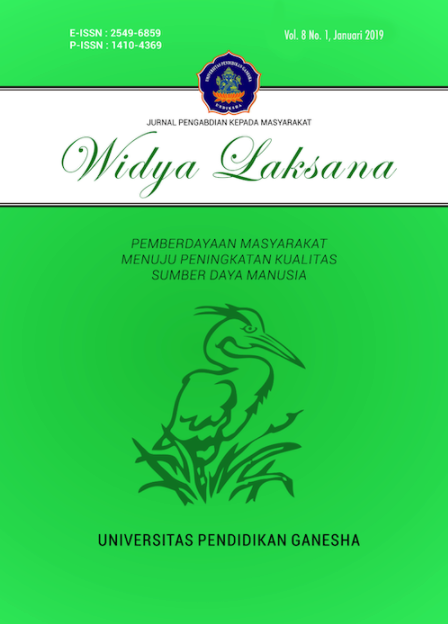Peningkatan Kemampuan Berpikir Kritis Kreatif Siswa TKJ SMK Negeri 2 Seririt Melalui Pelatihan Robot Bioloid
DOI:
https://doi.org/10.23887/jwl.v8i1.16041Abstract
With the development of robotics technology in almost every area of human life, education and teaching the concept of robotics is expected to be included in the education curriculum in secondary schools. Technology Vocational Schools are expected to build robotics technology and practice it. One of the Technology Vocational Schools in Buleleng Regency, Bali, namely SMK Negeri 2 Seririt became a partner for the development of the Workshop and Entrepreneurship in Engineering (PKR) subject through the application of robotics training. This training uses Bioloid robots to improve creative critical thinking skills to students in the Computer and Network Engineering (TKJ) SMK Negeri 2 Seririt. The results obtained include students being very enthusiastic in participating in training, students increased understanding in assembling and programming robots as well as students' creative skills and critical thinking skills increased up to 72%.References
Altin, H., & Pedaste, M. (2013). Learning Approaches to Applying Robotics in Science Education. Journal of Baltic Science Education, 12(3), 365–377. https://doi.org/10.1109/ROBOT.1994.351321
Angelo, T. A. (1995). Classroom Assessment for Critical Thinking. Teaching Psychology, 22(1), 6–7. https://doi.org/10.1207/s15328023top2201
Endarta, A. ; (2017). Literasi Pedagogi & Teknologi > Kurikulum 2013 > Struktur Kurikulum SMK 2017. Retrieved from http://duniapendidikan.putrautama.id/struktur-kurikulum-smk-2017/
Goh, H., & Aris, B. (2007). Using Robotics in Education: Lessons Learned and Learning Experiences. 1st International Malaysian Educational Technology Convention, (July 2015), 1156–1163.
Halim, S. (2007). Merancang Mobile Robot Pembawa Objek Menggunakan OOPic-R. PT Elex Media Komputindo. https://doi.org/10.31154/cogito.v3i2.67.164-172
Halpern, D. F., & Nummedal, S. G. (1995). Closing Thoughts about Helping Students Improve how they Think. Teaching of Psychology, 22(1), 82–83. https://doi.org/10.1207/s15328023top2201_24
Johnson, A. P. (2011). A Short Guide to Action Research (4th Edition).
Johnson, J. (2003). Children, Robotics, and Education. Artificial Life and Robotics, 7(1–2), 16–21. https://doi.org/10.1007/BF02480880
Loh, S. C., Loo, C. K., Loh, H. C., & Lim, Y. K. (2013). Transformative Robotic Education for the Realization of Malaysia National Philosophy of Education. Communications in Computer and Information Science, 376 CCIS, 416–426. https://doi.org/10.1007/978-3-642-40409-2_35
Marzano, R. J. ., Brandt, R. S. ., Hughes, C. S., Jones, B. F., Presseisen, B. Z. ., Rankin, S. C. ., & Suhor, C. (1998). Dimensions of Thingking: A Framework for Curriculum and Instruction. Association for Supercision and Curriculum Development.
Mendikbud RI. (2013). Permendikbud Nomor 73 Tahun 2013 tentang Kerangka Dasar dan Struktur Kurikulum Sekolah Menengah Kejuruan / Madrasah Aliyah Kejuruan.
Mubin, O., Stevens, C. J., Shahid, S., Mahmud, A. Al, & Dong, J.-J. (2013). A Review of the Applicability of Robots in Education. Technology for Education and Learning, 1(1). https://doi.org/10.2316/Journal.209.2013.1.209-0015
Taufiq Dwi Septian Suyadhi. (2010). Buku Pintar Robotika Bagaimana Merancang dan Membuat Robot Sendiri. Andi Yogyakarta.
Thai, C. N., & Paulishen, M. (2011). Using Robotis Bioloid Systems for Instructional Robotics. Conference Proceedings - IEEE SOUTHEASTCON, 300–306. https://doi.org/10.1109/SECON.2011.5752954
Turner, P. (2009). Tribotix - Educational Info: Why use Robots in Education. Retrieved from http://www.tribotix.com/EducationInfo/WhyRobotics.htm
Downloads
Published
Issue
Section
License
Authors who publish with the Widya Laksana agree to the following terms:- Authors retain copyright and grant the journal the right of first publication with the work simultaneously licensed under a Creative Commons Attribution License (CC BY-SA 4.0) that allows others to share the work with an acknowledgment of the work's authorship and initial publication in this journal
- Authors are able to enter into separate, additional contractual arrangements for the non-exclusive distribution of the journal's published version of the work (e.g., post it to an institutional repository or publish it in a book), with an acknowledgment of its initial publication in this journal.
- Authors are permitted and encouraged to post their work online (e.g., in institutional repositories or on their website) prior to and during the submission process, as it can lead to productive exchanges, as well as earlier and greater citation of published work. (See The Effect of Open Access)



